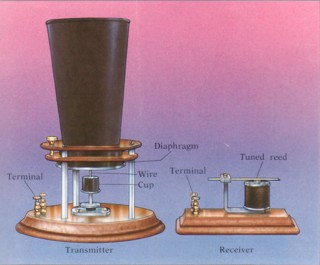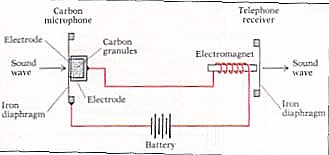WHAT
IS
A TELEPHONE?
Telephone
/ Long Distances / Switch
Boards / Phone Sounds
The
Telephone
A simple telephone
can be described as a transmitter, wires and a receiver. Bell and Gray's first
telephones used a liquid transmitter; Edison's used carbon.
|
|
Bell's Liquid
Transmitter
"A speaker's voice caused a diaphragm to vibrate; a small wire
attached to the center of the diaphragm moved up and down in a metal
cup of acidulated water. As the wire moved farther in or out of the
water, the electric resistance between the wire and the cup changed.
... the changes in resistance caused a changing current to flow through
the receiver."
Drawing by Tom Moore
(Pierce, 1990, p. 33)
|
|
A
Carbon Transmitter
"...is used in some telephone sets to this very day.
The motion of an iron diaphragm varies the pressure on carbon granules
confined between two electrodes. The variation in pressure causes the
electric resistance between the electrodes to vary, which in turn varies
the current."
(Pierce, 1990, p. 34)
|
|
These early telephones
were large and clumsy, and sounds made by them were unclear and very soft.
Later telephones combined receiver and transmitter into one unit. They were
smaller and worked better. Telephone receivers and transmitters of today are
more efficient. Microphones are either the condensor or electret type, and
receivers are moving-coil type.
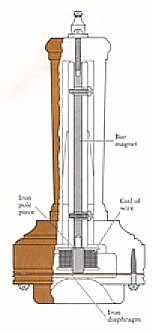
A single-piece transmitter
and receiver
(Pierce, 1990, p. 32)
Back
to Top of Page
Long
Distances
Beside the problem
of making telephone reception clear, sending a signal a long distance is a
problem. A recent National Geographic article, "The Future is
Calling," describes the problem of running cables around the world to
meet the increasing demand for more telephones:
"The
first wiring of the world began in 1850, only six years after Samuel Morse
demonstrated the reality of telegraphy. British engineers made a copper-wire
cable, insulated it with gutta-percha (a rubberlike Malayan tree sap), and
laid it across the English Channel. ... Soon
came a cable across the Atlantic. ...Queen Victoria sent a message to President
James Buchanan. Some of the words reached Washington that day; the rest came
through on the (next day). Agonizingly slow and chronically unreliable, the
cable went dead after three weeks. ... The problem was the behavior of electricity
in cables. Convinced that they had found the solution, engineers tried again,
this time with the world's largest ship. ... In July 1865 she set out from
England with a crew of 500, a dozen oxen for hauling, a cow for fresh milk,
a herd of pigs for bacon -- and a thickly insulated 2,800-mile cable that
weighed 5,000 tons. They had almost finished laying it when the cable snapped.
The next year they succeeded." (Allen, 2001, p. 83)
The article continues,
"It took a hundred years to connect a billion people by wire. It has
taken only ten years to connect the next billion people." The first hundred
years saw copper wire slowly lose favor to radio telephony, microwaves, and
satellite signals. In the 1990's cable finally made a comeback with fiber
optics. Bell saw this as a posibility with his photophone in the 1870's, but
it did not become a reality until over 100 years later.
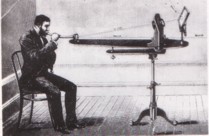
Alexander Graham Bell's Photophone, About 1880
"Bell contended that this was his greatest discovery, outranking
in potential importance even the telephone."
(Eber, 1982, p. 20)
Bell Laboratory Archives
(Connelly, 1999)
|
|

Fiber Optic Cables
David Parker
"A fiber optic cable is actually a center cable of
strong wire, six optical fibers, and copper wires to supply power to
repeaters. Thousands of calls per minute can be made over one cable
at a faster rate than standard copper wire."
(Parker, 1995, p. 26) |
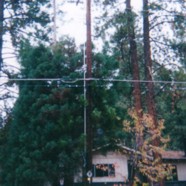
Local Area Repeaters are
used to boost the electrical signals,
but they are inefficient for long distance communication.
They are used in local areas about every 1/4 mile.
The long black "sausages" on the
bottom line are the repeaters
(Leah Schoelles, 23 Nov. 2001
Idyllwild, CA)
Back
to Top of Page
Switch
Board
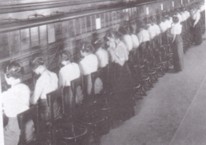 Sutter Telephone
Exchange,
Sutter Telephone
Exchange,
San Francisco 1914
Telephone Pioneer Communications Museum
(Fischer, 1992, p. 155) |
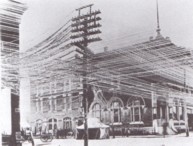
Telephone wires in a large city about 1900
Telephone Pioneer Communications Museum
(Fischer, 1992, p. 156) |
A third problem was the large usage of telephone wires - one for each telephone
was inefficient and became a problem in large cities. The wires were also unsightly
and could be a hazard in ice and snow storms. Cities and telephone companies
would have arguments about when the lines should be buried underground. The
number of wires was greatly reduced with the introduction of switching systems.
Almon Strowger
was the first to put the Connolly & McTigthe automated switching system
to practical use with the Strowger Automatic Telephone Exchange in 1891. Calls
became faster because they no longer relied on manual switching of calls by
groups of operators. Strowger
also had to make a rotary dial telephone that allowed callers to dial a telephone
number which sent the call to the correct switchboard. Until then, the operator
manually connected the call and checked the status of the telephone line.
Strowger's system meant that people needed to know if the line were busy or
available themselves. He created tones that each sounded different which told
the caller the status: the dial tone - the line is available for calls; the
busy signal - the number being called is in use; the line unavailable tone
- the circuit is busy; and the ring tone - lets the caller know the connection
was made.
To
hear each of the Strowger tones, click on the telephone below.
|
|
Dial
Tone |
|
|
Busy
Tone |
|
|
Line
Un-available Tone |
|
|
Ringing
Tone |
All tones provided by
"The Strowger Telecomms Page", 1996
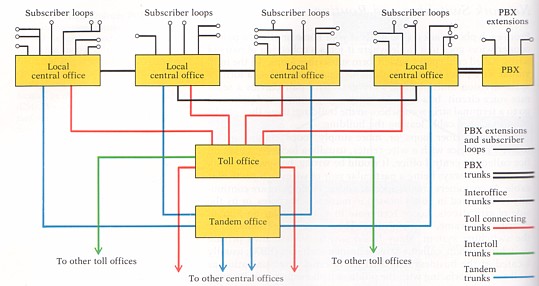
A telephone switching system
(Pierce, 1990, p. 188)
As the number of telephones
grew, a way had to be found to identify each telephone. To switch between
systems, a code was dialed to direct that call to a different exchange, then
the caller's number was dialed. This system is used today with the 3-digit
exchange number + 4-digit subscriber number. Area codes were added in 1947.
Area codes were originally for large cities, then they were applied to entire
states. Today, there are 9,999,999,999 possible combinations of area codes
and telephone numbers available.
Back
to Top of Page
Title
Page / Index / Inventors
/ Social Reaction / Off-Shoots
/ Photo Gallery / Timeline
/ Bibliography
